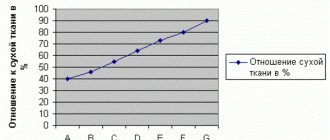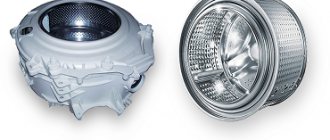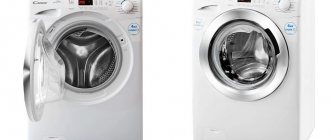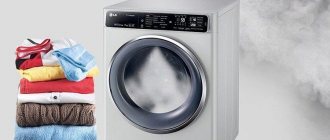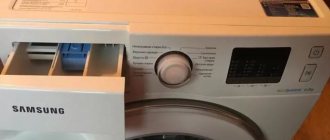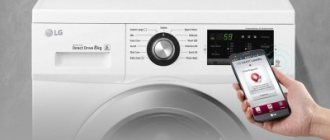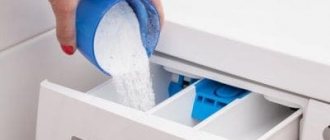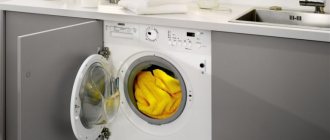What is the electricity consumption class?
The higher the class, the more efficiently the device uses the energy consumed, but because of this it is also more expensive. This parameter is one of the main indicators of the quality of household appliances. If you are looking for an economical washing machine, be sure to look at its energy efficiency rating. To make the choice easier for consumers, experts have developed a seven-point letter classification system for washing machines, which can be used to evaluate:
- quality of washing;
- spin quality;
- level of power consumption.
Until 2010, the classification from A to G was adopted, later a new scale began to be used - from A+++ to D. The methodology for establishing energy efficiency was also changed. To determine, compare the consumption of water and electricity under different conditions:
- when fully loaded;
- with incomplete loading;
- at different water temperatures throughout the year - on average 220 cycles are taken into account.
To make it easier for consumers to navigate the numbers, manufacturers came up with a classification of SMA based on energy efficiency. A multi-colored sticker is glued to the front panels of the equipment. Thanks to the pictures, the information is understandable to a native speaker of any language. The energy efficiency gradation is shown in different colors.
Washing machine power consumption
By determining the power consumption of the machine, we find out the amount of electricity used by the device. Against the backdrop of a total increase in utility bills, our desire to save on this parameter is understandable. A washing machine with low power consumption, with the same load, will cost much more than one that consumes more electricity. But over the service life, this difference in price can be fully compensated due to lower electricity consumption.
In plain language, the power of a washing machine increases, the more electricity it consumes, and accordingly, the less electricity it consumes, the more economical its use will be. It is worth knowing that the price of the unit also varies depending on the energy efficiency class.
How to determine the energy consumption class?
The problem is solved by relating actual and reference costs. Different models, having equal energy consumption, may belong to different energy consumption groups. It depends on how rationally they use water and how many revolutions they produce. That is why, when choosing an automatic washing machine (AWA), you need to look at all the characteristics in a comprehensive manner. Each device has a sticker informing the consumer about:
- energy efficiency;
- brand and model;
- annual energy consumption, kWh;
- annual water costs, l;
- spin and drying class A-G;
- maximum load, kg;
- noise, dB.
Today, the majority of SMAs offered on the market have energy consumption class A or B. If the equipment is marked with the letters F or G, it does not deserve attention - its quality can be characterized as bad and very bad, respectively. Devices with energy consumption classes D and E - normal and satisfactory - are rarely found on the market. Before assigning energy saving classes to SMA for each parameter - washing, spinning, energy efficiency - a comparison is made with the standard.
How many kilowatts does a washing machine consume?
According to the rules, the power consumption level is marked on the information sticker. It can be found attached to the body of the machine. The power indicator specific to a particular model can usually also be found in the user manual for the washing machine. Today's automatic washing machines are equipped with power ranging from 2000 to 4000 watts. This parameter is determined by the design capabilities of a particular model.
What is the standard?
The standard for assessing the capabilities of equipment is not a simple SMA, but a special installation with stable performance indicators. The device under study is compared with the reference one. To evaluate the washing ability of the model, special reference rags are washed. To estimate energy consumption, find out how much electrical energy is consumed during a test wash. Tests are carried out at a temperature of 60 °C. Loading: 1 kg of cotton fabric.
Based on the test results, the obtained indicators are compared with the reference ones, and the SMA is assigned the appropriate group. The energy consumption table allows you to determine how much energy the device spends in 1 hour when loading 1 kg of cotton fabric. To find out the energy costs when the drum is loaded, you need to multiply the corresponding power consumption (it is indicated in the energy consumption table) by the weight of the laundry.
| Consumption class | Power consumption, kW/h per kg |
| A (A+++, A++, A+) | 0,13-0,17 |
| IN | 0,17-0,19 |
| WITH | 0,23-0,27 |
| D | 0,27-0,31 |
| E | 0,31-0,35 |
| F | 0,35-0,39 |
| G | more than 0.39 |
How to choose?
The reference wash performance is not the only criterion for energy consumption. SMA modifications are distinguished by optimization of the programmable mode. For example, if you need to wash heavily soiled clothes, a machine with energy efficiency group C will spend 2.4 hours. And its more economical competitors from group A will wash the same thing in just 2 hours. Thanks to this, savings are achieved: better means faster. The less time the machine spends on washing, the less electricity it costs.
Manufacturers are constantly improving technology, equipment is becoming more and more efficient. If before 2010 there was only efficiency A, today it is divided into A+, A++ and A+++ - SMAs with such icons consume 10, 30 and 50% less, respectively.
Energy-efficient washing machines are more expensive - is it worth the overpayment? Considering their service life, it’s worth it. Budget versions last at least 5 years, good ones - 15-20 years. During this time, you can save a lot of energy.
What affects power consumption?
- Mode. The longer the wash cycle and the hotter the water, the higher the energy consumption.
- Loading. The more laundry the SMA washes, the more energy it uses.
- Life time. As it is used, scale deposits on the heating element - the efficiency of the heating element decreases, it cannot heat water as efficiently as before. Electricity costs are rising. To prevent overconsumption and preserve the heating element, use descaling agents in a timely manner.
It is difficult to accurately calculate costs, and it is not necessary - the main thing is to choose an economical machine.
What components consume energy in washing machines?
To determine the power of a washing machine, let’s find out which of its components absorb electricity in the greatest quantities. Let's list the main ones.
- A heating element (tubular electric heater) has the function of heating water in a special container. Its performance is directly related to the washing stages of the intended program. During washing with cool water, the operation of this device may not be required. But during boiling, the intensity of the heating element reaches its greatest power. Each heater that is built into the machine has its own power rating. The value will be in the range of 1.7-2.9 kW. The higher the indicated indicator, the more quickly the heating is carried out and the higher the energy consumption.
- The engine is the most important component of the device. Its mission is to ensure that the drum rotates at the right time. The type of engine installed in the machine determines its power. The average can vary from 0.4 to 0.8 kW. The spin phase accounts for the greatest energy consumption.
- The control module is a structure of components that controls all operations of the unit. This is kind of the brains of the whole machine. The entire unit consumes about 1 - 0.5 kW.
- The pump is put into operation of the machine at several stages; if necessary, pump out water from the reservoir after use. Consumes a small amount of electricity - from 0.25 to 0.45 kW.
The power of the entire unit largely depends on the amount of energy consumed by the engine and electric heater. The determining factor in cost is the program performed by the machine and the time required for washing. Another significant point is how long the machine has been in use.
Model overview
To ensure your SMA uses electricity economically, pay attention to its efficiency. Let's see what the market offers and how washing machines belonging to the middle price category have proven themselves.
The following are the most rated models in their groups.
Electrolux EWW 51476 WD - “B”
Modification with drying - up to 4 kg. There are 3 drying programs. Touch control. Backlit display. Direct drive - the device operates quietly. The body is white. Timer - up to 20 hours. 49/75 dB - noise level. There is a compartment for liquid powder.
Specifications:
| Energy consumption, kW*h/kg | 0,14 |
| Maximum load, kg | 7 |
| Spin speed rpm | 1400 |
| type of instalation | freestanding |
| Load Type | frontal |
| Tank material | plastic |
| Energy class | IN |
| Washing class | A |
| Spin efficiency class | IN |
| Water consumption, l | 52 |
| Number of programs | 10 |
| Dimensions, (WxDxH), cm | 60x52x85 |
| Weight, kg | 68,4 |
| Cost, rubles | 42 000 |
| Drying | No |
Users praised:
- quiet operation;
- good drying;
- simple controls.
Noticed disadvantages:
- vibrates a little during the spin cycle;
- small load if wash and dry;
- Ineffective steam function.
There are many complaints about breakdowns - electric shocks, the pump, heating element, etc. break. The main advantage of this model is dry laundry at the exit. It is because of this function that it belongs to group “B”. Drying clothes on a line or sacrificing energy costs - everyone decides for themselves.
Indesit IWUB 4085 - “A”
A narrow white model with a removable lid - can be built under the sink or into furniture. Intelligent control. Delay timer - up to 12 hours. Noise during washing/spin - 59/76 dB. The hatch diameter is 30 cm.
| Energy consumption, kW*h/kg | 0,15 |
| Maximum load, kg | 4 |
| Spin speed rpm | 800 |
| type of instalation | freestanding |
| Load Type | frontal |
| Tank material | plastic |
| Energy class | A |
| Washing class | A |
| Spin efficiency class | D |
| Water consumption, l | 39 |
| Number of programs | 13 |
| Dimensions, (WxDxH), cm | 60x33x85 |
| Weight, kg | 66 |
| Cost, rubles | 10 800 |
| Drying | No |
Benefits according to users:
- Many useful programs;
- Compact - shallow depth;
- Easy to operate;
- Affordable price;
- Express mode for 15 minutes;
- Shoe mode;
- Repairable.
Flaws:
- There is no express mode in hot water;
- Vibrates during the spin cycle;
- Poorly distributes things during the spin cycle;
- It takes a long time to wash and consumes a lot of electricity.
The main complaints about this model stem from its relatively low energy efficiency - long washing times, high energy consumption.
Samsung WF8590NLW9 - “A+”
There is a removable cover for installation. With intelligent control. White body. Noise - 60/74 dB. Ceramic heater.
| Energy consumption, kW*h/kg | 0,17 |
| Maximum load, kg | 6 |
| Spin speed rpm | 1000 |
| type of instalation | freestanding |
| Load Type | frontal |
| Tank material | plastic |
| Energy class | A+ |
| Washing class | A |
| Spin efficiency class | WITH |
| Water consumption, l | 48 |
| Number of programs | 8 |
| Dimensions, (WxDxH), cm | 60x45x85 |
| Weight, kg | 53 |
| Cost, rubles | 15 700 |
| Drying | No |
This model is praised for its ease of operation and trouble-free operation. Samsung products, as always, are at their best - the Koreans, introducing their own energy-saving technologies, produce some of the most economical models. Users noted with approval the following points:
- Auto-weighing;
- Adjustment of temperature and speed;
- No vibrations.
Owners especially like the flexibility of settings - if you don’t have the right program, you can select the basic functions yourself. The disadvantages are that it is difficult to reach the filter, short hoses, and only partial protection against leaks.
LG F-1296TD4 - “A++”
With removable cover for installation. Silver body. Delayed start timer - 19 hours. Noise level - 54/65 dB.
| Energy consumption, kW*h/kg | 0,17 |
| Maximum load, kg | 8 |
| Spin speed rpm | 1000 |
| type of instalation | freestanding |
| Load Type | frontal |
| Tank material | plastic |
| Energy class | A++ |
| Washing class | A |
| Spin efficiency class | IN |
| Water consumption, l | 56 |
| Number of programs | 13 |
| Dimensions, (WxDxH), cm | 60x55x85 |
| Weight, kg | 62 |
| Cost, rubles | 24 600 |
| Drying | No |
Users like this machine for its spaciousness, stylish design, economical water consumption, uniform distribution of laundry, silent operation and the ability to wash large items. The disadvantage noted is rather subjective - it is an irritating signal. Also a disadvantage is the lack of memory, which does not allow you to save custom programs.

